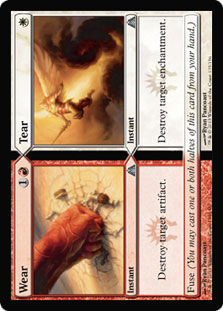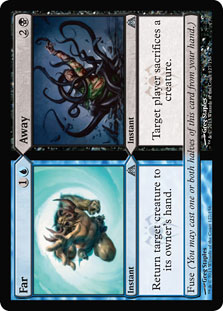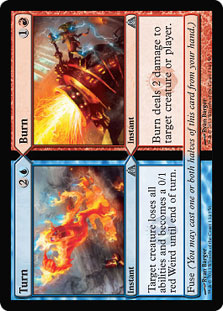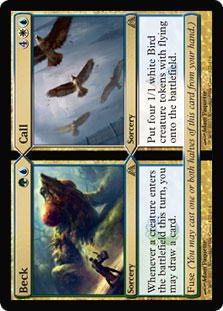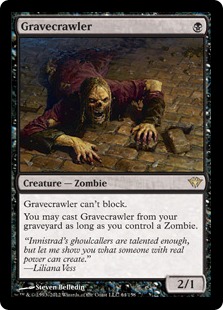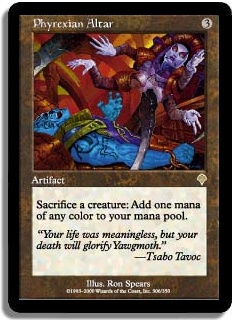So, you’re saying there’s two ways to look at this?
No, I’m saying you can look at it both ways at the same time…
…
For a 166-card set, Dragon’s Maze sure is coming at us fast, and it’s not joking around. I suppose the revealing of the land slot being used for shocklands, Guildgates, and Maze’s End is a big factor, as that’s well over 5% of the set right there. Still, that’s not even a third of the cards previewed thus far.
The biggest reveal so far has got to be the new split cards. Split cards first debuted in Invasion, which featured a cycle of ally-colored split cards; the most notable of this aggressive cycle was Assault // Battery. Apocalypse followed this up with a cycle of enemy-colored split cards with mixed response, the most famous of which was Fire // Ice.
It would not be until the original Ravnica block’s third set, Dissension, that we would see split cards return. This time, we saw a cycle of uncommon split cards that featured two allied gold cards that shared a color and a cycle of rare split cards that featured two enemy gold cards that shared a color. A little investigation reveals the most noteworthy as Research // Development.
Finally, a few split cards appeared in the alternate reality of Planar Chaos from a world where split cards were mono-color. The most widely used of these was Dead // Gone, but we never really got to compare it to split cards of other colors since Planar Chaos featured only a sampling of red splits and that alternate timeline has long since passed.
Now, truth be told, split cards have appeared countless other times over the years—at least in spirit. After all, isn’t every modal card a split card? However, there’s something about full-on split cards (at least the non-Planar Chaos ones) because they feature two very different options that are more than just an A or B choice but alternate casting costs. One thing they have never been able to do, however, is give you both.
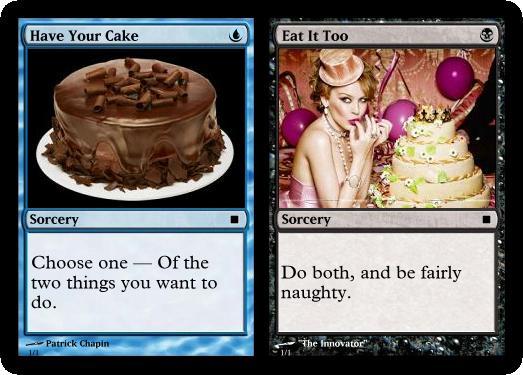
Split cards are back in Dragon’s Maze, but this time they function more like entwine cards. Entwine let you play either half (like a normal split card) or both halves for an added cost. The difference? Both modes of the entwine cards cost the exact same, with a cost to do both that varied from card to card. This made them modal spells that let you do both for a kicker cost.
Fuse cards are actually bona fide split cards—you just happen to also have the option to get both by paying the combined casting cost. This makes them all effectively three-way split cards. For example, here is the most straightforward of the new split cards:
While it appears that most of the new split cards have synergy between the two modes (one of those sum is greater than the parts type of affairs), Wear // Tear is just a good clean, simple design that gives us all things we want.
The three modes:
1. Shatter
2. Demystify
3. Hull Breach at instant speed for 1RW
Hull Breach at instant speed would be only slightly weaker than Hull Breach itself (a very successful tournament card), but when you include the option to do either half at instant speed for less cost, we’re starting to get into the actually better than Hull Breach space, which is pretty impressive.
This era of Magic is not exactly best known for a need for artifact and enchantment removal; however, it is still valuable utility that there is regularly use for. Additionally, this sort of effect is extremely valuable for Modern, Legacy, Vintage, and Commander.
When is Wear // Tear going to be good enough?
Well, compare it to the modes of Naturalize or Disenchant:
1. Shatter
2. Demystify at double the cost
That’s it.
Clearly, Wear // Tear is significantly stronger than Naturalize or Disenchant, both of which have proven their worth over the years. The only real advantage of a card like Disenchant over Wear // Tear is that you only need one color of mana to be able to take advantage of its modes. In general, if you have access to both white and red mana, Wear // Tear is just going to be the very best pure Disenchant we have access to.
Now, if you’re playing an older format, you may value things like Krosan Grip’s split second or Dismantling Blows card draw, but you’ll have to pay for them. If you just want a straight Disenchant, this is the best one even if you don’t plan on using both halves at the same time. The fact that you can is just gravy.
Ok, seems easy enough to understand. Not all of the new split cards are just two utility spells that mirror each other. In fact, most of them tell a story with two modes that synergize with each other.
On the surface, Far // Away looks like a pure utility card as well. Unsummon for 1U and Diabolic Edict for 2B are both reasonable options that we might be willing to pay an extra mana for in exchange for having both options. What makes the card really sweet, though, is the ability to combine them for added effect.
Edict effects can be quite powerful and are among the best answers to hexproof creatures and other creatures with defensive abilities. What is the classic way to play around them? Well, putting out a second creature. That way, if they spend their turn playing the Devour Flesh or whatever, they will hit the other creature.
It’s not just that we can remove two creatures at instant speed when we fuse Far and Away—we can actually bounce the weaker of the two creatures and force them to sacrifice the better!
Interestingly, Far // Away has a lot more options than we might guess on the surface since Unsummon is already basically a split card:
- Bounce an opponent’s creature
- Bounce one of your creatures
This means there are actually a shocking number of ways that we can play Far // Away once we consider all the options that involve potentially targeting our own creatures. For instance, an opponent might try to Murder your Nightveil Specter, which you respond to by returning it to your hand and forcing them to sacrifice a creature.
Of course, Unsummoning your own creatures isn’t just a purely defensive move. Cards like Snapcaster Mage, Restoration Angel, and Augur of Bolas make bouncing your own creatures another form of card draw. Imagine a mid-game sequence of Far on your Snapcaster Mage and Away forcing them to sacrifice a creature.
Next turn, you can Snapcaster Mage your Far // Away, bouncing your Snapcaster Mage again and forcing them to sacrifice yet another creature. In fact, a single Snapcaster Mage lets you chain all of your Far // Aways together, giving you a lot of free Edicts.
Augur of Bolas isn’t as reliable but still turns this into yet another source of card advantage. Don’t even get me started on Thragtusk…
It’s a little expensive, but that you have a number of cheap options goes a long way towards increasing its utility. Far // Away has a lot of competition for these utility effects, but it gives you a lot of great options.
While these two abilities synergize, some of the new split cards almost transform into totally different cards if you combine them. Perhaps the loudest of these is Turn // Burn:
On the surface, this looks like your choice of Ovinize and Shock, paying a one-mana premium for all the options. What’s really interesting about this pairing, however, is that it lets you build a Murder. Spend five mana and you can make a creature small enough to die to Shock…and then Shock it!
Shock is obviously a lot more playable than Ovinize, so a lot of people are viewing this as a two-cost Shock with kicker 2U that lets you kill the creature. If this is all you are going to do with it, that isn’t a great rate (at least not for Constructed). Five-mana kill spells are great in Limited but aren’t the greatest option for Constructed.
However, there is more to the story. First of all, blue and red are two colors that don’t always have the easiest time killing large creatures. They are often going to be willing to pay a premium for a Murder type of effect, particularly one that comes with other cheaper options.
More importantly, however, Turn // Burn can actually kill two creatures. You don’t have to target the same creature with both halves. It takes some set up, but you can actually shrink your opponent’s big creature in combat while Shocking a smaller one. This makes the card a pretty insane limited card, but it’s far from a guarantee of Constructed success.
While I think Turn // Burn has chances (particularly in Block), too many of the good creatures in current Standard are either really cheap or draw you a card in some way, making me value the truly novel effect (blue/red getting a Murder) lower than I would in other formats. It’s totally worth considering, but I am less optimistic about this one.
Some of the few split cards actually open up the possibility of new archetypes. For instance:
Toil // Trouble is actually a fascinating card to consider because it can be used as a general utility card or as the cornerstone of a whole new deck. As a utility card, we have the option of an easier to cast Sign in Blood for one mana more or a sorcery speed Sudden Impact—for a mana less!
What? It’s not even clear that Trouble by itself isn’t better than Sudden Impact, a card with Standard Pro Tour Top 8s on its resume. Sudden Impact is the type of effect that really excels as an Instant, but spells costing less is a pretty big game.
One of the big weaknesses of Sudden Impact, though, is that it doesn’t really have a lot of utility to it. If you aren’t in a position to try to burn someone out (or they just don’t have any cards in hand), it doesn’t really do anything at all.
Toil // Trouble is the exact opposite. Not in a position to burn an opponent out? Perhaps they have no cards in hand? Cash it in for two more cards! Sign in Blood is not so powerful an effect that I just want four Toils in every black deck even when they can’t cast Trouble, but against control decks it’s a pretty great deal. It’s also an effect that slower non-blue black decks really need. This combined with Olivia Voldaren, Rakdos Keyrune, and Rakdos’s Return suggest that Mono-Black Control is going to splash red for the foreseeable future, though Rakdos’s Return + Toil // Trouble is a strange sort of pairing (though still synergistic in a “just kill them outright” sort of way).
Ok, both options are pretty appealing on this one, so it’s already a winner, but what makes Toil // Trouble a head-turning cornerstone of a possible new archetype is what happens when you combine them. Like Sign in Blood, you can point the card draw spell at your opponent when you just need those last two points. Of course, if you wait until you have six mana, you can point both halves at them and do the final four points—when they have zero cards in hand!
That means for six mana, we actually get the Sudden Impact + four points of damage, which could easily be a killing blow. How many cards do opponents have in hand on the sixth turn? Obviously, there’s a huge range, but that number can easily be four to seven if they are playing anything other than an aggro deck. While you can really punish someone who taps out to play Prime Speaker Zegana, even just hitting a random Esper or Jund deck will generally result in somewhere in the vicinity of eight or nine points of damage(!)
That is an outrageous amount of reach to give a deck. It’s not clear Magic has ever had a better Storm Seeker variant, and every previous version has spawned decks around them, generally fueled by cards like Howling Mine.
The only real Howling Mine variant in Standard at the moment is Otherworld Atlas, but perhaps we can still build a Howling Mine burn deck.
4 Pillar of Flame
2 Geistflame
4 Searing Spear
4 Skullcrack
4 Toil // Trouble
4 Brimstone Volley
2 Flames of the Firebrand
3 Tribute to Hunger
4 Otherworld Atlas
4 Bonfire of the Damned
2 Stensia Bloodhall
4 Blood Crypt
4 Dragonskull Summit
9 Mountain
6 Swamp
Of course, we don’t need to be so one-dimensional. There are actually a lot of potentially exciting synergies utilizing Toil // Trouble. For instance, Cyclonic Rift is a totally reasonable card that we might just want to play. Maybe we use it largely as defensive tool with Toil as another card drawer. However, when the opportunity arises, we end step Overload Cyclonic Rift, putting every nonland card they control back into their hand. Now, untap and Toil // Trouble and we’re talking about a boatload of damage (generally eleven).
Such could regularly find itself getting up to eight or nine mana, leaving the door open to an endgame of:
1. Cyclonic Rift their entire board on their end step turn 8.
2. Untap, play a land, and Toil // Trouble them.
3. Use your final three mana to Trouble them again (with another copy but this time not fused).
As long as the Cyclonic Rift fills their hand to hand size, that’s a full 20 damage right there!
I’m not sure where Toil // Trouble will end up, but it sure does look pushed. Sudden Impacts haven’t been the type of card you just jam into decks, but they have basically all ended up finding homes and this one seems the strongest yet.
While all of the split cards discussed so far have been uncommons with two single color sides, Dragon’s Maze also features a cycle of rare fuse split cards with two sides that share a color. This five-card cycle features the five allied pairings (the Shards, if you will), which interestingly slightly unbalances the guilds since this means two extra options for each allied guild (Gruul, Azorius, etc.) and nothing for the enemy guilds (Izzet, Orzhov).
The split card that appears to be generating the most hype has got to be Beck // Call:
The reason for the hype? Beck is a more powerful Glimpse of Nature, albeit at a cost of UG instead of G. Adding a mana to Glimpse’s cost is certainly not trivial, but we’re talking about a pretty overpowered card to begin with.
Additionally, Beck has improved functionality over Glimpse since it triggers whenever a creature enters the battlefield this turn. The primary functional change here is it triggering off of tokens. This really changes evaluations of cards like Nest Invader; Spider Spawning; Talrand, Kuldotha Rebirth; Krenko, Mob Boss; and Empty the Warrens. While Beck can be used to make new Glimpse of Nature style combo decks, these decks can now include token making to great effect.
It also triggers off of opponents’ creatures. This may seem minor since how many people are going to play their Restoration Angel after letting your Beck resolved, but it also triggers when opponents get creatures they didn’t plan on. For instance, play a Hunted Phantasm after Beck and you draw six cards!
Ok, so Beck could have been printed by itself and it wouldn’t be a loser. What about Call? After all, it is a full on flashed back Lingering Souls for just a one-mana premium, right?
That is true, but we wouldn’t really be jumping to play Lingering Souls for five if it was all one spell. It would be fine, of course, but nothing close to the tournament powerhouse Lingering Souls is. At six? Well, that is comfortably into the space of “not good enough to play just for that one option.”
Fortunately, that isn’t all it is.
Have you ever played a Glimpse of Nature deck and found yourself in a spot where your board is decimated by a sweeper and you have no cards in hand? Drawing Glimpse is the beginning of a plan, but it’s pretty far from going off. However, Beck // Call off the top also gives us the option of spending 4WUUG to draw four cards and put four 1/1 fliers on the table. That is a pretty darn good back-up plan, and even if we can’t produce the full eight mana, the ability to make four fliers for six can let us switch gears and try to grind out a victory the old-fashioned way.
It’s totally conceivable that someone may put Beck // Call into a control deck that isn’t even really trying to combo as an odd sort of Cruel Ultimatum. It’s not a homerun if you just want to play it for eight, but it’s pretty darn good. For a mana more, it draws as many cards as Cruel Ultimatum—and replaces the Edict, Mind Twist, and five points of drain with four Birds.
Yeah, obviously Edict + Mind Twist + drain for five is way better than four Birds, but that’s a pretty high bar and, frankly, using this purely for the eight-mana mode is just not nearly as efficient.
Of course, such a deck could find a number of other ways to get value out of Beck // Call. Restoration Angel counts as two creatures (since the creature it Blinks will also trigger Beck), as does Huntmaster of the Fells. Neither of these is super mana efficient, however, making us work to turn Beck into a two-mana Divination on turn 6. Angel of Glory’s Rise + Beck is a pretty big game, but so is Angel of Glory’s Rise + Saltine cracker.
While the door is certainly open to using Beck // Call as a value card, the ceiling of how good this can be is significantly less exciting than how busted Beck can be doing a solo (or basically solo) act.
First of all, the obvious:
4 Nettle Sentinel
4 Heritage Druid
4 Llanowar Elves
4 Wirewood Symbiote
3 Birchlore Rangers
2 Fyndhorn Elves
1 Quirion Ranger
4 Elvish Visionary
3 Priest of Titania
1 Mirror Entity
1 Viridian Shaman
1 Regal Force
4 Green Sun’s Zenith
4 Glimpse of Nature
3 Beck // Call
1 Dryad Arbor
1 Pendelhaven
2 Gaea’s Cradle
4 Tropical Island
2 Savannah
2 Misty Rainforest
1 Windswept Heath
1 Wooded Foothills
1 Verdant Catacombs
2 Forest
Beck // Call is even a blue card, so if we wanted we could add Brainstorm and only be a few cards from being able to support Force of Will.
Of course, there are a lot of other options. For instance:
4 Ornithopter
4 Memnite
4 Shield Sphere
1 Kobolds of Kher Keep
4 Wild Cantor
4 Tinder Wall
4 Elvish Spirit Guide
4 Simian Spirit Guide
1 Retract
2 Kuldotha Rebirth
2 Shared Discovery
4 Glimpse of Nature
4 Beck // Call
1 Empty the Warrens
1 Grapeshot
4 Mox Opal
4 Chrome Mox
4 Lotus Petal
1 Gaea’s Cradle
3 City of Brass
This list is surely unplayable as is, but it points to a possible way to try to really break Beck // Call. Basically, there have been a number of decks worked on over the years that had the fatal flaw of “good when they draw Glimpse but don’t work without it.” The ability to play eight Glimpses totally changes the landscape. I mean, if you wanted you could actually play twenty zero-cost artifact creatures and twelve Kobolds, so the sky is really the limit on zero-cost creatures if you can find a way to get ahead.
Of course, there are other ways to try to break Beck besides zero-cost creatures or Elves. What do both of these have in common? They aspire to create game states where you are playing creatures that don’t net cost you mana. There are other ways to do this, of course. Even a single Shrieking Drake does the trick if you can find a way to make drawing a card worth at least a mana.
Earthcraft is one possible way to do this but is banned everywhere but Vintage. The upside to this sort of a deck in Vintage, though, is gaining access to four Skullclamps. Four Skullclamps, four Glimpse of Natures, and four Becks? That is a lot of ways to turn dorks into card draw.
Gravecrawler is another possible creature to loop if only you can sacrifice it for at least one black mana. Fortunately(?), Phyrexian Altar exists.
Assemble the combo and you can draw your entire deck (Glimpse, of course, being able to replace Beck). Interestingly, this isn’t the only Zombie combo you can put together with Beck. Zombie Infestation triggers Beck, so if you get two of them running, you can actually just cycle through your entire deck and make a very large horde of Zombies. After drawing your deck, it takes just a single kill card to finish the job (perhaps a way to give them all haste). Zombie Infestation combos with Gravecrawler, though the Infestation combo doesn’t work with Glimpse. Interestingly, though, this means the combo is completely Modern-legal.
Firecat Blitz is another out-there possibility with Beck, as it lets you cash in as many lands as you like for cards (and attackers). Really, the key is cards that can produce more tokens than the amount of mana they cost. The dream is a card that lets you discard cards to make tokens without requiring mana at all. Even if they are 0/1s, it forms a loop.
Aiming slightly lower, Beck is sure to spawn a new Modern deck in the style of Elf combo. We may not have Glimpse or Green Sun’s Zenith, but we do have Beck, Chord of Calling, and Summoner’s Pact. Might we imbue it with some sort of a token subtheme? Might this be a time to reconsider cards like Sprout Swarm and Intruder Alarm?
Whether we’re using the new fuse split cards as versatile utility cards or flagships of new archetypes, it’s clear they are going to be some of the most impactful cards in Dragon’s Maze. Almost 10% of the set is split cards, which is pretty wacky. The implications are hard to predict, but figuring these cards out is going to be one of the top challenges for the format to come.
With spoiler season in full effect, I’ll be back Wednesday to examine more Dragon’s Maze previews. What cards would you like to see covered? Let me know, and I’ll see you then!
Patrick Chapin
“The Innovator”

